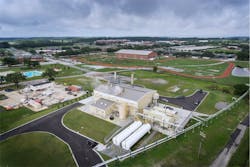In a move that could spur more military microgrid projects, the Department of Navy has adopted a resilience policy to enable key installations to go off-grid for at least two weeks by late 2025.
The US Navy and Marines Corps aims to have “assured energy whenever and wherever it’s required,” according to the Installation Energy Resilience Strategy released March 13.
Navy and Marine Corps energy managers must reach out to utilities and private sector experts to collaborate on initiatives to reduce vulnerabilities, add redundancy and improve energy management, Lucien Niemeyer, Navy acting assistant secretary for energy, installations and environment, said in the plan.
“We must pursue innovative methods to supplement funding through the privatization of assets, continued performance contracting, and the acquisition of energy as a service,” Niemeyer said.
The military has already been an early leader in microgrid development with several projects in operation. The two-week resilience plan mirrors a similar policy already enacted by the Army.
How the resilience plan will work
The strategy calls for installation energy managers to assess facility reliability and resilience requirements for all facilities by September 2021.
They must then develop plans to increase energy reliability for defense and “task critical” assets to 95% by September 2025. They must also make sure those assets can operate off-grid for at least two weeks by the same deadline.
Finally, starting in 2022, energy managers must be moving to make all defense and task critical assets resilient and reliable by 2030, according to the strategy.
“The department must optimize the use of every available authority to accelerate delivery of secure and reliable energy,” the Navy said in the plan.
The department pursues improved power generation using whichever technology is the most economical, available and resilient, according to the plan.
Read more about military microgrids on Microgrid Knowledge.
The Navy noted it has successfully entered into public-private partnerships to develop distributed energy projects.
The plan highlighted Navy and Marine Corps projects at Marine Corps Air Station Miramar and Guantanamo Bay in Cuba.
The Marine Corps has installed a microgrid at the Miramar base in California. The project has 11.2 MW of on-site generation, including diesel, natural gas, landfill gas and solar.
The Navy hired Siemens Government Technologies to set up a resilience project at the Guantanamo base that included 12 MW of solar and an 8 MW energy storage system on top of existing generating assets at the site.
The report comes as the Navy is dealing with aging energy infrastructure that is making it harder for shipyards, piers, maintenance facilities, armories, magazines, training ranges, simulators, weapons systems, and shore-based communications to be fully prepared to meet their mission, according to the department.
Track news about military microgrid projects. Subscribe to the free Microgrid Knowledge newsletter.







